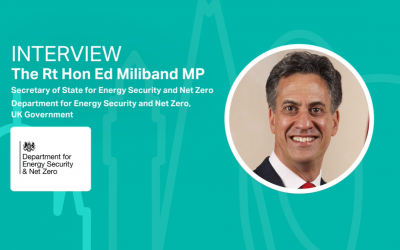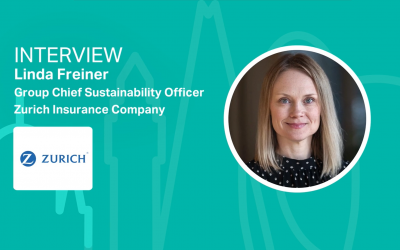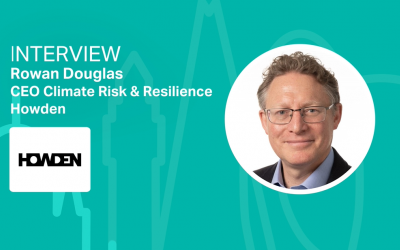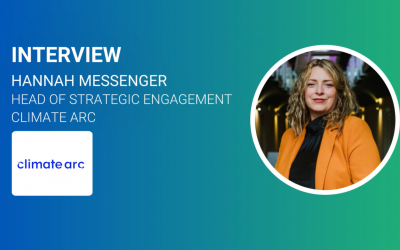From Principles to Practice: UNEP FI’s Joana Pedro on Driving a Just Climate Transition in Finance
Joana Pedro from the UN Environment Programme Finance Initiative (UNEP FI) spoke to Climate Action about the critical role of financial institutions in supporting a just transition to a net-zero economy. She shared insights on aligning capital with inclusive climate goals, overcoming implementation challenges, and the importance of stakeholder collaboration ahead of COP30 in Brazil.

As the global economy moves toward decarbonisation, ensuring the transition is fair, inclusive, and socially equitable is more urgent than ever. Financial institutions face growing pressure not only to align with climate goals, but to do so in ways that support workers, communities, and vulnerable populations at risk of being left behind.
Joana recently spoke at the Climate Action and UNEP FI 8th Annual Sustainable Investment Forum Europe in Paris. She has played a leading role in embedding social considerations into climate finance—shaping global frameworks and guiding investors on integrating just transition principles into practice.
Q1. From your perspective at UNEP FI, what does a truly "just transition" look like in practice—and why is it a critical pillar in the shift to a carbon-neutral economy?
A truly just transition ensures that the move to a low-carbon, climate-resilient economy is both environmentally sustainable and socially inclusive. In practice, this means proactively investing in reskilling, expanding social protection systems, and promoting inclusive governance to safeguard workers, communities, and vulnerable populations—particularly those in carbon-intensive sectors or regions. A just transition also involves maximizing and equitably sharing the benefits of the shift, such as new employment opportunities, better health outcomes, economic growth, and enhanced energy security. It is a critical enabler of climate action, as it helps build the broad societal consensus needed to support long-term climate objectives.
Q2. Many investors and institutions have made public commitments to a just transition. What are the biggest barriers you've seen in moving from good intentions to measurable outcomes?
While it’s encouraging to see public commitments from financial institutions, these need to be matched with concrete actions at the governance, engagement, and reporting levels. A number of barriers stand in the way. Chief among them are short-term financial pressures that often deprioritise long-term social investment, and the limited integration of just transition principles into institutional strategies and operations. Many institutions also struggle to incorporate environmental and human rights due diligence into their core decision-making. Furthermore, there is often inadequate engagement with affected stakeholders, and a lack of cohesive, comparable metrics to track and report on just transition impacts. Addressing these challenges is key to turning intentions into real-world outcomes.
Q3. Why is collaboration on standards and definitions so vital for responsible investors aiming to support a just transition?
Shared standards and definitions are essential to ensure comparability, credibility, and efficiency in directing capital toward climate action that delivers inclusive social outcomes. Without a common understanding of what constitutes a "just transition," it becomes difficult to measure impact or build trust in the financial system’s role. This is where UNEP FI plays a pivotal role—convening stakeholders to co-create relevant frameworks. One notable example is Just Transition Finance: Pathways for Banking and Insurance, which was developed with over 60 financial institutions, international bodies, academics, and civil society partners. The guidance offers practical recommendations on embedding just transition principles into financial products and operations, in alignment with both the Paris Agreement and human rights obligations.
Q4. What progress has been made in aligning financial institutions around common social metrics and accountability mechanisms within climate finance?
Momentum is building in this space. While frameworks like the Task Force on Climate-related Financial Disclosures (TCFD) did not address social factors, newer frameworks such as the Taskforce on Nature-related Financial Disclosures (TNFD) include recommendations for stakeholder engagement, especially with Indigenous peoples, local communities, and affected groups. The upcoming Taskforce on Inequality and Social-related Financial Disclosures (TISFD) is developing guidance specifically focused on social and inequality-related metrics, designed to be interoperable with TCFD and TNFD.
In the European Union, the Sustainable Finance Platform has also issued guidance encouraging companies to embed just transition considerations into corporate transition planning via people-centered, human rights-based approaches. Yet, greater harmonization and widespread adoption are still needed. UNEP FI contributes by developing tools such as the Human Rights Toolkit and supporting collaborative workstreams that help financial institutions embed social accountability into their climate strategies.
Q5. Can you share examples of financial institutions or investor alliances that are setting best practices in aligning capital with socially inclusive climate outcomes?
Several financial institutions are beginning to integrate just transition principles into their financing strategies. For example, BNP Paribas is advancing its NEST initiative to support small and medium-sized enterprises (SMEs) and vulnerable populations in managing the transition with minimal economic disruption. Barclays has implemented a framework to assess not only the technical quality of their clients’ climate transition plans but also their social impacts—looking at how affected stakeholders are involved and what mitigation measures are in place. Meanwhile, PNC Bank has formed a National Community Advisory Council to bring the perspectives of community leaders and NGOs into its lending, investment, and service initiatives. These cases show how financial institutions can align climate action with inclusive outcomes by integrating social equity into product design, risk management, and stakeholder engagement.
Q6. What role does UNEP FI play in bridging the gap between voluntary principles and enforceable standards?
UNEP FI serves as a key bridge between high-level commitments and on-the-ground implementation. We support institutions through the development of practical tools—such as the Climate Mitigation Journey, the Human Rights Toolkit, and Just Transition Finance: Pathways for Banking and Insurance. We also facilitate peer-to-peer learning and foster collaboration to share best practices across the financial sector. Crucially, UNEP FI engages with regulators and standard-setters to ensure voluntary principles align with evolving policy and regulatory frameworks. Our contribution to the G20 on integrating just transition considerations into financial sector planning is one such example. This bridging role ensures that voluntary commitments are more likely to lead to real, measurable impact.
Q7. How can investors better engage with governments, labour unions, and civil society to ensure transition plans are inclusive and equitable?
Engaging with a broad range of stakeholders—including SMEs, Indigenous peoples, and local communities—is essential to creating transition plans that are both inclusive and responsive. Investors can strengthen this engagement by participating in multi-stakeholder dialogues that reflect local needs, supporting public-private partnerships and innovative financing models that channel resources toward reskilling, infrastructure, and social protection. Collaborating with community investment funds, capacity-building initiatives, and technical assistance programs can further drive sustainable development. Additionally, financial institutions can play a vital role in advocating for policy frameworks that align climate goals with human rights and social equity priorities.
Q8. As we look ahead to COP30 in Brazil, what outcomes would you most like to see in terms of social safeguards and just transition frameworks within global climate agreements?
COP30 offers a unique opportunity to embed just transition principles in global climate agreements. The concept of “Mutirão”—a Brazilian tradition of community-led, collective action—could provide a compelling model for inclusive and participatory transition planning. Key outcomes we hope to see include the recognition of just transition as a core pillar of climate policy and finance, along with commitments to embed social safeguards and human rights due diligence in transition finance mechanisms.






